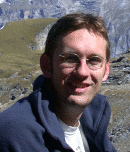The Project
Full Moon: Novel constraints on the origin and evolution of the lunar interior and the early Earth.
Winner

Dr Willem van Westrenen
Department of Petrology
Vrije Universiteit Amsterdam
De Boelelaan 1085, 1081 HV, Amsterdam
The Netherlands
http://www.falw.vu.nl/petrology
Dr Willem van Westrenen is 33 years old and gained his PhD in Experimental Petrology from the University of Bristol (UK) in 2000. Prior to joining Vrije Universiteit as a lecturer, he undertook his Postdoctoral research at the Carnegie Institution of Washington DC and later at ETH Zurich. He has a good publication record, with 23 listed publications, all in high level journals, including one in Nature.
He said: “I am most delighted to receive this award. A key result of this project will be a greatly improved understanding of constraints on the interior composition and evolution of the moon. It has direct applications related to future space missions, and also in a wider context to problems such as understanding volcanic eruptions on earth and other planets.”
Provisional Award
€ 1,249,816
Project Description
Our Moon formed from the debris of the most dramatic event in the Earth’s history: a giant collision between the young Earth and a Mars-sized impactor. This collision had enormous effects on the constitution and differentiation of our planet, ultimately controlling the plate tectonic processes that produced present-day landforms, atmosphere, and life. Understanding the current working of the Earth’s interior requires detailed knowledge of this collision event. The Moon retains information about this earliest history due to the absence of plate tectonics, but existing models for lunar origin and evolution lack consistency and accuracy. To constrain the impact’s key role in the evolution of the Early Earth I propose to develop a fully consistent physical and chemical model for the origin and evolution of the Full Moon.
Novel constraints on the physical properties and compositions of the materials forming the lunar crust, mantle and core will be obtained using a multidisciplinary approach.
Lunar rocks will be subjected to high pressures and temperatures to study their properties at conditions prevalent in the Moon. A Full Moon model will be synthesised by combining the results of these experiments with the latest lunar surface compositional data from space missions, and with computer simulations of the dynamics of the early lunar interior. This will be the first instance in which the evolution of a complete planetary body is modelled using direct measurements of physical and chemical properties at all relevant pressures and temperatures, without having to resort to extrapolation. Constraints provided by our approach are expected to lead to unprecedented insight into the Moon-forming impact and its effect on the Early Earth. The methodologies developed will form the foundation for models of larger planetary bodies, specifically Mars, the target of future exploration by ESA and NASA.
*Petrology is a field of geology which focuses on the study of rocks and the conditions by which they form. There are three branches of petrology, corresponding to the three types of rocks: igneous, metamorphic, and sedimentary. The word petrology itself comes from the Greek word "petra", meaning rock.

